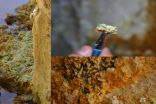Protein recognition and disorder: A debate
2013-01-11
(Press-News.org) The extent to which three-dimensional structure is required for protein recognition and function is an area of vigorous debate with clear implications for protein engineering. Two differing viewpoints have been put forward in two articles published in F1000 Biology Reports today.
In structuring their arguments, the authors were encouraged to consider the opposing viewpoint, examine the points put forward and critique them in their own articles. This novel collaborative approach has given rise to a considered exchange of ideas and may consequently stimulate further research in the field.
In their article entitled "The case for intrinsically disordered proteins playing contributory roles in molecular recognition without a stable 3D structure", Keith Dunker (Indiana University School of Medicine) and Vladimir N. Uversky (Russian Academy of Sciences and University of South Florida) argue that the lock and key model of protein recognition cannot be upheld as a universal truth. They argue that some proteins without a rigid structure, intrinsically disordered proteins (IDPs), still have function.
In contrast, Joël Janin (Université Paris-Sud) and Michael J.E. Sternberg (Imperial College, London), in their article "Protein flexibility, not disorder, is intrinsic to molecular recognition", argue that a protein's function in the real world environment of the body's cells is dependent on the structure of that protein, and that protein recognition requires regions of complementary structure binding to each other. Janin and Sternberg also note that many proteins seem to be disordered in the test tube but are in fact proteins waiting for partners (PWPs), which then adopt fully ordered structures in the presence of other components of the cell required to perform a function.
To counter the argument put forward by Janin and Sternberg, Dunker and Uversky conclude that the major difference between ordinary proteins and IDPs is that the former fold first and then bind to their partners while that latter remain disordered until they bind their partners. Furthermore, some IDPs can be much more dynamic than just "waiting for a partner", with the ability to switch from one partner to another and change structures while changing the partner.
Commenting on the two articles, Richard Henderson, MRC Laboratory of Molecular Biology, Cambridge said: "Both articles are by leaders who have given a great deal of thought to the function of proteins that appear to be intrinsically unfolded. Their different emphases will no doubt stimulate experiments as well as debate in the Structural Biology community. Time will tell us whether one or both models reflect how nature uses these structures."
###
To find out more about Faculty of 1000, please contact Eleanor Howell. For more information, visit http://f1000.com. END
ELSE PRESS RELEASES FROM THIS DATE:
2013-01-11
Researchers at the Centre of Astrobiology have identified microorganisms that live inside salt deposits in the acidic and ferrous environment of the Tinto River in Huelva, Spain. The extreme conditions of these microniches appear to be similar to those of the salt deposits on Mars and Jupiter's moon, Europa. This possibility should be borne in mind on missions operating in these places, such as Curiosity.
The high doses of radiation, lack of moisture and extreme temperature and pressure on the surface of Mars make the development of life difficult. Within this hostile ...
2013-01-11
An enzyme treatment which could neutralise the effects of lethal chemicals responsible for the deaths of hundreds of thousands of people across the world has been developed by experts at the University of Sheffield.
Organophosphorus agents (OP) are used as pesticides in developing countries and acute poisoning is common because of insufficient control, poor storage, ready availability, and inadequate education amongst farmers.
It is estimated about 200,000 people die each year across the world from OP poisoning, through occupational exposure, unintentional use and misuse, ...
2013-01-11
Athens, Ga. – Even when at rest, the human body is a flurry of activity. Like a microscopic metropolis locked in a state of perpetual rush hour traffic, the trillions of cells that make us who we are work feverishly policing the streets, making repairs, building new structures and delivering important cargo throughout the bustling organic society.
For everything to work properly there must be something to organize and direct the various workers. Enter protein kinases. Like specialized traffic signals, this huge class of proteins is critical for many aspects of cell communication, ...
2013-01-11
Researchers used induced pluripotent stem cells (iPSCs) derived from a young patient with Long QT syndrome (LQTS), a congenital heart disorder, to determine a course of treatment that helped manage the patient's life-threatening arrhythmias. The results, which appear in The Journal of General Physiology, could lead to improved treatments for LQTS and other channelopathies, diseases caused by disturbed ion channel function.
iPSCs—adult cells that have been genetically reprogrammed to function like embryonic stem cells—provide a valuable tool for studying diseases and ...
2013-01-11
This press release is available in German.
Animals have developed a variety of strategies for dealing with increasing noise pollution in their habitats. It is known, for example, that many urban birds sing at a high pitch to differentiate their song from the low-frequency sound of road traffic. However, as scientists from the Max Planck Institute for Ornithology discovered, this is just a useful side effect. The real reason for this behaviour is that songs at a higher pitch are also automatically louder. The birds can make themselves heard far better in city noise ...
2013-01-11
This press release is available in Spanish.
By examining what lady beetles eat, U.S. Department of Agriculture (USDA) scientists are learning more about the movement of these beneficial insects in farm fields—and whether they'll actively feed on crop pests.
Agricultural Research Service (ARS) entomologist Jonathan Lundgren at the North Central Agricultural Research Laboratory in Brookings, S.D., and former ARS entomologist Michael Seagraves were part of a team of ARS and university scientists that examined how a lady beetle's diet alters its feeding patterns and ...
2013-01-11
Peering deep into the dim edges of a distorted pinwheel galaxy in the constellation Ursa Major (the Great Bear), astronomers at Case Western Reserve University and their colleagues have discovered a faint dwarf galaxy and another possible young dwarf caught before it had a chance to form any stars.
Within the faint trails of intergalactic traffic, the researchers also found more evidence pointing to two already known dwarf galaxies as probable forces that pulled the pinwheel-shaped disk galaxy known as M101 out of shape.
M101 is the dominant member in a group of 15 ...
2013-01-11
With 41 states having reported widespread and severe outbreaks of flu this season, timely new research sheds light on why less than half of the American population has gotten a flu shot.
Despite widespread knowledge that a vaccine is the best way to reduce the chances of catching and spreading the flu, even three of the four main TODAY show anchors recently admitted they had not gotten a flu shot (until they did so live on the air).
Using an online computer game that simulates the spread of an infectious disease among its players, researchers at Wake Forest University ...
2013-01-11
In what they acknowledge as a seismic shift in the ethical foundation of medical research, practice and policy, a prominent group of interdisciplinary healthcare experts, led by bioethicists at Johns Hopkins, rejects an ethical paradigm that has guided the American system since the 1970s and calls for morally obligatory participation in a "learning healthcare system" more in step with the digital age. The group has authored a pair of articles outlining their arguments and proposal for a new ethical framework, which appear in a special report from The Hastings Center Report, ...
2013-01-11
Think of the epigenome like a giant musical mixing board, turning up or down the expression of various genes. A University of Colorado Cancer Center study published today in the journal PLOS Genetics shows that in cancer, not only can genes themselves go bad, but abnormal changes in the epigenetic mixing board can unfortunately change the expression of these genes. Researchers hope to play the role of sound engineers, controlling these harmful epigenomic changes to turn down cancer itself or perhaps sensitize cancers to existing drugs.
The epigenome's primary tool – ...
LAST 30 PRESS RELEASES:
[Press-News.org] Protein recognition and disorder: A debate


